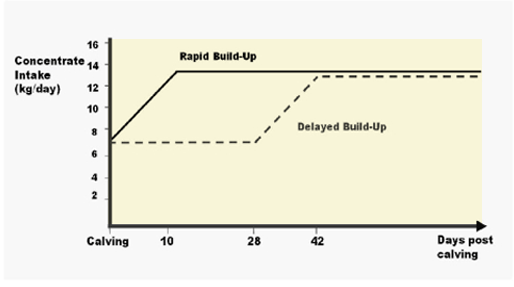



Building Up Concentrate Feed Levels Slowly - Are There Benefits?
During early lactation high yielding dairy cows are unable to consume sufficient food to support high levels of milk production, writes Andrew Dales, from the Agri-Food Biosciences Institure, Northern Ireland. As a result the cow utilises her own body reserves for milk production and is said to be in negative energy balance. However, prolonged periods of negative energy balance are detrimental to production, health, and reproductive performance, and as such we should try to reduce the level of negative energy balance that cows experience.
Increasing the quality of the diet offered, for example by feeding more concentrates in early lactation, is the approach most often adopted to help meet the higher nutrient requirements of higher yielding dairy cows. This approach has been widely adopted in Northern Ireland with CAFRE benchmarking data indicating that the average concentrate input on benchmarked dairy herds in Northern Ireland increased from 1.1 to 2.1 tonnes per cow per year between 1998 and 2009. However, higher yielding cows often just produce more milk when concentrate feed levels are increased, and as such energy balance may not be improved.

In addition, high concentrate diets can lead to rumen acidosis, resulting in impaired rumen function and lower intakes. An alternative approach might be to increase concentrate feed levels gradually in early lactation. This may have a number of possible benefits. For example, a slower build-up of concentrates post calving may delay peak milk yield until closer to the time when maximum dry matter intakes have been achieved, and as such, reduce the extent of negative energy balance experienced by the cow. Reducing the concentrate load in early lactation may also improve rumen stability and total dry matter intake. However to date little research has been undertaken to examine the effect of a slow rate of concentrate build-up.
Research programme
This issue was addressed in an experiment at the Agri-food & Biosciences Institute (AFBI) Hillsborough (co-funded by DARD and AgriSearch), involving 60 winter-calving Holstein-Friesian dairy cows. Half of the cows in this group were managed on a system involving a rapid build-up of concentrates in early lactation, while the other half were managed on a system in which early lactation concentrate build-up was delayed. Full details of the diets offered are described below, and presented in Figure 1.
Figure 1.Schematic of concentrate allocation within the rapid and delayed build-up treatments

From calving, cows in both groups were offered a mixture of grass silage, maize silage and concentrates which provided approximately 7.0 kg of concentrate per cow per day (target dietary protein content of 15 per cent). With the rapid build-up treatment, an additional 7.0 kg of concentrate was introduced into the diet via an out-of-parlour feeder during the first 10-days post calving so that the total concentrate intake by day-10 post calving was approximately 14 kg per day. Cows on the delayed build-up treatment received no additional concentrate until day-28 of lactation, at which point concentrates were introduced over a 14 day period, so that total concentrate intake by day-42 post calving was approximately 14.0 kg per day. When cows were receiving their full concentrate allocation (7.0 kg in basal diet plus 7.0 kg through out-of-parlour feeder) the protein content of the diet was 18 per cent on a dry matter basis (Figure 1). Cows remained on these two dietary treatments until day 150 of lactation.
Cow performanceAs expected, cows on the delayed build-up treatment had a higher forage intake in early lactation, with this corresponding to the period before the additional concentrates were introduced into the diet (Figure 2). However, it was interesting to note that these cows continued to maintain a higher forage intake than those on the rapid build-up system throughout the entire experimental period. In terms of rumen health, 45 per cent of cows on the rapid build-up strategy experienced a digestive disorder in early lactation compared to seven per cent of cows on the delayed build-up treatment.
Figure 2.Forage intake during the first 140 days of lactation

Despite differences in the intake of concentrates and forage between treatments, total dry matter intake was unaffected by concentrate build-up strategy (Table 1). Furthermore, neither milk yield nor milk composition was affected by concentrate build-up strategy (Table 1). However, from weeks three to seven post calving, cows allocated to the delayed build-up treatment produced 3.5 kg less milk per day than those allocated to rapid build-up treatment.
Despite the lack of treatment effects on milk production, cows on the delayed build-up treatment returned to positive energy balance earlier (week-7 post calving) than those on rapid build-up treatment (week-19 post calving). This effect is due to improvements in dry matter intake throughout the experimental period and a lower milk yield during weeks three to seven of lactation. While energy status was improved, concentrate build-up strategy had no significant effect on any of the fertility parameters measured within this study (Table 1). However, a higher number of cows were pregnant at the end of the breeding period with the delayed build-up feeding strategy.
Adopting a delayed concentrate build-up strategy in early lactation improved forage intake and rumen health and had no detrimental effect on production performance. While there were no significant treatment effects on fertility, there was a trend for cows on the delayed build-up strategy to have improved fertility.



